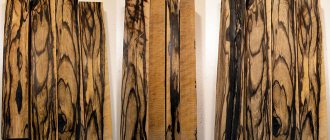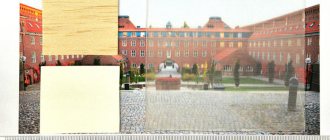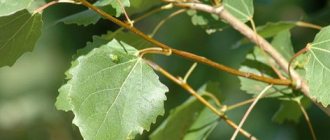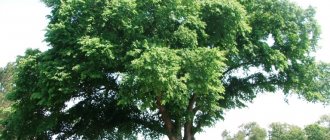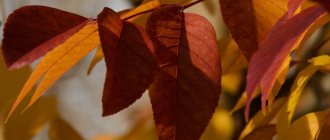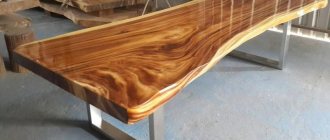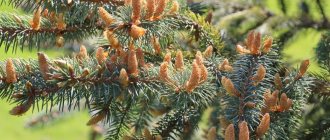Historical reference
The ebony tree is called by different names: mugembe, black tree, “tree of music”, mpingo, “zebra tree”. Since ancient times, people have used the bark, leaves and wood of the ebony tree and attributed magical properties to them. Black wood items were discovered in the tomb of Pharaoh Tutankhamun. This valuable material was brought to Egypt from East Africa. It was believed that weapons made from wood from the ebony family could kill evil spirits and demons. The amulets symbolized the courage and bravery of their owner, and, according to beliefs, brought strength and dexterity.
African tribes used ebony to make charcoal because its wood has extraordinary hardness and great heat output.
Magical properties were often attributed to ebony products. For example, ebony boxes were intended for storing magical items in order to preserve their qualities.
Ebony is a tree that has wood with a black core, which was the reason for giving the name “Ebony” to the wood of different types of plants with such properties.
Ebony mainly grows in Asia, Madagascar and, of course, Africa. The most valuable varieties are considered to be wood obtained from Ceylon, Cameroon, Macassar and Madagascar ebony trees.
The durability of Ebony, unusually high hardness for wood and the ability to be polished to a mirror shine distinguish Ebony from all others. African ebony is still the most beautiful, expensive and rare tree in the world.
The most incredible, sometimes mystical and mutually exclusive properties are attributed to ebony. To this day, ebony is used in magical rituals and in traditional medicine among many peoples of the Dark Continent. Figurines carved from ebony were used by sorcerers, as they were believed to be the abode of spirits, and were used as talismans and amulets. In folk medicine, the bark and roots of the ebony tree are used, as they are believed to have healing properties and cure various ailments from headaches to fever.
But since ancient times, ebony wood has been of true value, which, due to some of its characteristics, has not so much mystical properties, but serves as a very beautiful and original ornamental material. Despite its high density and hardness (density is more than 1000 kg/cm3), ebony is well processed and polished, after which the processed surface becomes perfectly smooth and shiny, making it look like metal. The tradition of making figurines and figurines to decorate the interior decoration of noble and wealthy nobles goes back to ancient times. This is evidenced by archaeological finds and descriptions of ancient authors. In the burial chambers of the Egyptian pharaohs, among objects and jewelry made of precious metals, there were often items made of ebony. According to ancient beliefs, ebony was credited with the ability to resist poisons, so beautiful and expensive dishes were made from it.
Due to its hardness and water-repellent properties, ebony is widely used in the manufacture of high-quality musical instruments - violin and guitar necks, piano keys, and wind instruments. But ebony is especially widely used in the manufacture of expensive furniture and furniture facades. Furniture made from this material was elegant and, despite its apparent fragility, very durable. In our time, ebony, unfortunately, has lost its former prevalence due to mass thoughtless cutting down in an effort to profit from the sale. Products made from ebony are mainly exclusive and very expensive.
For many African peoples, ebony is the main material in the traditional art of wood carving. African figurines, masks depicting deities and spirits, amazing in their grace and plasticity, are in great demand all over the world. It is believed that the spirit living in ebony and endowing it with magical properties will not allow everyone to start working with it, and if it does allow it, it will guide the master’s cutter in order to give the finished product perfect lines and lightness of shape.
The legend of one of the African tribes tells of a wild, shaggy creature who lived in an empty cave all alone. It ate raw meat, plant roots and slept on bare ground. Taking pity on him, the spirit living in the mpingo (ebony) tree advised him to carve a female figurine. When the creature carved out the figurine, good spirits breathed life into it and it turned into a beautiful woman - the ancestor of the tribe and taught him the ability to think, speak, feel, and the qualities inherent in man. Since then, wooden figurines of the ancestor have served as amulets and decorations for the people of the tribe, and women enjoy universal honor and respect.
Jewelry, amulets, miniatures and souvenirs made of Ebony (Ebony) - more details...
Interior items and souvenirs
Ebony wood, due to its unique properties, is ideal for mechanical processing in the manufacture of various items: figurines, knife handles, souvenirs.
The most skilled ebony carvers are the Makonde people. They make extraordinary expressive sculptures from ebony. The work uses a method of joining materials that differ in texture: carefully polished elements and cut out without processing.
Today, the value of ebony is also high; chess, backgammon, canes, boxes for wine, cigars, decorative elements, photo and picture frames, handles for blades and much more are made from this elite material.
Wood or fruit?
The ebony tree belongs to the Persimmon genus. Many people know this genus for its sweet, fleshy, bright orange fruits. But the fruit of the ebony tree is not always edible. Delicious fruits are produced by Oriental, Caucasian and Virginia Persimmon, as well as the Maloba and Black Sapota varieties. Today, persimmons can be grown in any country with a warm climate. Chocolate varieties and large berries resembling a black apple appeared on sale. Even the Philippines has started growing an edible variety of persimmon, with bright red berries called "Velvet Apple". In Israel, the “Sharon” variety was developed, which has no seeds and has no astringent taste. These fruits are bought by supermarkets in many countries. Other varieties are better known for their valuable wood.
Applications of ebony
Due to its high price, this type of wood has never been widely consumed. In ancient times, it was valued on a par with gold. Ebony furniture has been valued since the times of the Egyptian pharaohs. The most sought-after properties are the ability to obtain a perfectly smooth surface after polishing. This result is not possible with any other type of wood. Ebony visually resembles metal, which is complemented by a noticeable coldness upon contact with its surface.
Indonesian variety - Makassar ebony
Trees of this species grow in Indonesia. This ebony is classified as a colored species. The base of the wood is black, but it has characteristic yellow and light brown stripes that create a beautiful pattern. Among the ebony varieties, the Makassar variety is one of the densest.
When processed, this type of ebony wood, like all others, forms a dense and persistent dust. It may irritate the skin and cause red eyes. In addition, this dust is harmful to the lungs.
Ceylon view
Ceylon ebony is considered the highest quality and most expensive type of black wood. It is very hard and polishes perfectly. The variety is classified as finely porous, which affects its quality. Ceylon ebony is not afraid of exposure to water. This wood is called Black Ebony. All expensive trinkets and furniture of the 16th-19th centuries were made from wood of this type.
Black walnut: contraindications
Due to the enormous biological activity of the substances, preparations from this plant are contraindicated:
- small children under two years old;
- for allergy sufferers;
- pregnant women;
- nursing mothers;
- losing weight;
- overweight people;
- people with individual intolerance to the substances included in the drug.
Excessive consumption of nuts can also cause harm to the body. A child’s consumption of more than 10 pieces at a time can lead to spasm of cerebral vessels and inflammation of the tonsils. Abuse of them can lead to unpleasant consequences: dizziness, stomach cramps, nausea, vomiting and constipation.
You should strictly adhere to the dosage of taking medications that contain black walnut. Benefit and harm can be equal.
Watch an interesting video about black walnut - a powerful product with complex health benefits!
Ebony - processing
Sawing and cutting wood is a labor-intensive process that requires the use of tools of high strength and sharpness. The texture of ebony wood is practically not saturated with liquids, but the surface is well polished, acquiring a mirror shine. Treatment with an antiseptic or coloring compound is not necessary. Drying the wood takes a long time. A couple of years before cutting down, circular notches are applied, which stop the growth process. After the felling, drying is carried out in the shade without drafts. After hot steaming, many types of ebony bend well.
Characteristics of wood
Trees from the Ebony family, which have valuable wood, have powerful trunks. The diameter of many plants exceeds 1 m, and their height is up to 10 m. Ebony trees grow very slowly, which is what gives the wood greater density. According to its characteristics, the density of black wood is more than 2 times higher than the density of oak.
The bark and sapwood of the ebony tree are of no value. They are used only by local healers for their potions and craftsmen for household utensils. Unfortunately, the bark and sapwood that is removed before sale can account for 60-70% of the entire trunk.
In addition to its high density, heartwood has oiliness and the ability to withstand changes in temperature and humidity without loss of stability. Ebony can have black, chocolate and lilac-violet heartwood. It can be uniform or striped; there are no discernible annual rings in the heartwood. This type of valuable wood does not rot and is not susceptible to damage by insects.
Trees and shrubs with green and yellow bark
The unusualness of woody plants with such trunks is off the charts. Those of them that do not change the green color of the bark throughout their lives are called stem assimilants by botanists:
- whipweed (Spartium junceum);
- some gorse (Genista);
- ephedra (Ephedra);
- naked jasmine (Jasminum nudiflorum);
- bamboos, primarily bamboos (Phyllostachys), and others.
Their trunk and branches partially perform the function of leaves, that is, photosynthesis also occurs in the bark.
In the Garden you can see not only the species listed above, but also green maple (Acer tegmentosum) from the Far East. In the same category of color in central Russia we will again be amazed by dogwoods: the greenest form of blood-red dogwood (C. sanguinea f. viridissima) and the cultivar of the scion (C. stolonifera) 'Flaviramea' with green and bright yellow-green winter shoots. Parallel to them in the south, but at any time of the year, golden bamboo with yellow straws continues to amaze.
Golden bamboo in the foreground, photo by the author
To be precise, this is the golden form of the bambusoides (Phyllostachys bambusoides cv. Allgold), which is better known as the 'Castillon' form, or Castillon bamboo. Its curtains grow slowly at first, but remain quite dense and do not grow excessively. Propagated by peripheral shoots of the rhizome. It is most decorative when planted in shade, on dense, moist soils.
We suggest you read How to prune a lemon tree at home
Features of trunk blackening
In some cases, the development of black cancer is accompanied by several other signs.
Drying
This symptom indicates the possibility of getting rid of the disease only to a certain extent. Affected areas that cannot be restored must be cut out and burned, and living tissues should be treated with disinfectants, dried and anointed with garden varnish.
Appearance of wet areas
If a trunk damaged by cancer begins to get wet, this means that the dead part of the wood is inhabited by putrefactive bacteria. In such a situation, you will need to strip it down to healthy tissue, followed by treatment with a solution of vitriol, which effectively destroys harmful bacteria and fungi.
Formation of white growths
The appearance of white growths is a signal that the apple tree has been colonized by tinder fungi.
Because these organisms prefer to grow on dead wood, their presence indicates that the tree is sick. If it is not too late, you need to immediately begin getting rid of fungal growths and treating the disease.
Bark cracking
The appearance of cracks in the bark is the first sign of infection with black cancer of fruit trees.
It is possible to save the culture by carrying out a number of operations: stripping to healthy tissue, disinfection with copper sulfate and treatment with garden varnish. If the total area of the trunk is affected by more than 50%, the effect of treatment will be zero.
Elimination of black spots
When dark spots are detected on the bark of a trunk, it is important to immediately carry out proper treatment, since their presence indicates the development of black cancer. The operation algorithm is as follows:
- cleaning affected areas;
- pruning to live bark;
- disinfection;
- applying garden varnish to a dried area.
Blackening of stem branches
Severely affected stem branches are recommended to be pruned and burned. An apple tree with a well-developed root system is capable of forming a new crown in just 2 years. As a result, the gardener will acquire a rejuvenated tree that produces an abundant and high-quality harvest.
Trees and shrubs with red and brown bark
Perhaps these are the most spectacular breeds. Owners of such trunks often become dominant in the composition and everyone’s favorites.
Winter colors of the South Coast, photo by the author
Traditional red-barked shrubs in central Russia and to the north have become:
- white dogwood (Cornus alba, syn. Swida alba, Thelycrania alba), its forms 'Sibirica', 'Kesselringii';
- scion (C. stolonifera, syn. C. sericea) and its cultivar 'Kelseyi' - shoots red, yellow-green in winter;
- blood red (C. sanguinea) and its forms 'Winter Beauty' and 'Winter Flame' - shoots are bright orange-yellow and red in winter.
It is their purple-red or brown-red shoots that become bright accents in a winter garden dusted with white snow. They are visible from afar: I noticed them in the squares and parks of St. Petersburg from the window of a trolleybus.
Young shoots of white dogwood, photo by the author
When planting decorative dogwoods in your dacha, you should remember that only regular pruning of old branches, which stimulates the formation of young shoots with red bark, will give the maximum decorative effect. An ugly old bush can regain its youth and sparkle with bright colors if you gradually, over several years, trim off the oldest branches. Radical pruning is less effective.
Among the trees with red bark for growing in dachas in central Russia, the most realistic ones are:
- bird cherry (Padus maackii);
- including Pennsylvania (P. pensylvanica).
